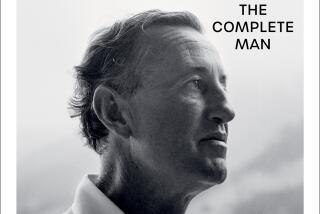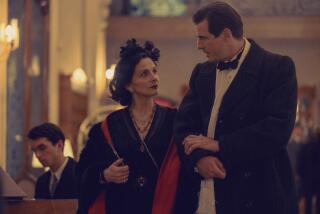The Crown and the Mole
- Share via
If I declare an interest in this book, I also confess a tiny resentment. As far as I know, I was by a narrow margin the first person to name Sir Anthony Blunt, in print, as the long-sought “fourth man” of Soviet penetration in the British Secret Service. I did so in the New Statesman in 1979, narrowly beating (allowing for discrepant deadlines and publication dates) the editors of the satirical magazine Private Eye, who get the credit in Miranda Carter’s book and elsewhere. This may seem a petty way of approaching a major scandal, but the struggle to publish an open secret was and is an important key to understanding the surreal world in which Blunt rose, flourished, prospered--and ultimately fell like Lucifer. I knew that Sir Anthony was the culprit, but had I simply published the fact, I could have been exposed to a very serious suit for libel. I could also have involved myself in breaking the Official Secrets Act, which defines almost all public information in Britain as state property.
However, the Fleet Street press had got wind of the fact that the guilty man’s name had five letters, began with B and belonged to a person who had been at Cambridge University in the 1930s. At least one blameless don--a man named Donald Beves--had been extensively calumniated in The Times (of London) for no better reason. (Oddly enough, the author of the original rumor was a journalist with the equally suspect name of Andrew Boyle, who produced a sensational book titled “The Climate of Treason.”) A climate of something more like witch-hunting had resulted. There seemed no good reason to allow this to go on, since the British authorities had known since 1964 that Blunt had been an agent of the KGB. So I went ahead and ventilated the name, body-guarding my disclosure with various careful phrases about how Sir Anthony was innocent until proved guilty and so forth.
What a relief it was when Margaret Thatcher rose in the House of Commons a short while afterward to confirm what the establishment had so long kept to itself. Her statement had one very important feature, which is missing from Carter’s “Anthony Blunt: His Lives,” and indeed from most accounts of the Cambridge spy saga. Seeking to explain how it was that so many double agents had infiltrated British intelligence, she said that in 1939 and 1940, there had been some rather hasty recruitment to meet the Nazi menace, and a few rather dubious characters had therefore slipped through the mesh. This was in fact, in the guise of an excuse, an enormous admission. It involved conceding that, until almost too late, the establishment spymasters had been either indifferent to Hitler or somewhat sympathetic to him.
That ugly but plain fact, with its corollaries, had provided the future traitors with their justification as well as their opportunity. Kim Philby, the most successful mole of all time, had pretended to be a Nazi sympathizer in order to get himself recruited by MI6. He had gone to Spain to report glowingly from the Franco side and joined the pro-Hitler Anglo-German League. His collaborators, Guy Burgess and Donald Maclean, were not so flamboyant in their deception but were motivated by a similar hatred and contempt for an upper class that had been so collusive with fascism throughout the 1930s. Until his death in 1995, one of the most successful of the British double agents, John Cairncross, lived unprosecuted in France, where he was an acknowledged expert on Moliere, Racine and Corneille. He was distinctly proud of having sent the Soviet Union wartime information about tanks and other materiel, which is credited by historians with having helped the Red Army to win the Battle of Kursk.
Since most of us do not wish that the Kursk salient had fallen the other way, nobody has ever quite nerved himself to call Cairncross a traitor. However, the relatively idealistic Cairncross was one of those with access to the crucial codes known as “Enigma,” and it has been speculated, most notably by British historian and former intelligence officer Hugh Trevor-Roper, that anyone sharing these with Stalin at the wrong moment could have ended up, even if unintentionally, also sharing them with Hitler. Cairncross’ name, incidentally, was given to the British authorities by Blunt as part of the plea bargain by which he saved his own skin. I am stressing this macro-political dimension because Carter, in what is a mostly excellent case study, has chosen to concentrate almost exclusively on the interior psyche of her subject. Without the inconveniences of his second career as a spy, Blunt might well have become internationally recognized as an art critic. His work on Nicolas Poussin, though challenged by subsequent art historians, certainly assisted in establishing the seriousness with which that painter is now taken. (Blunt’s insistence on the primacy of the aesthetic trumped all his other loyalties: He could never bring himself to praise Picasso’s “Guernica” even when the party line might have mandated otherwise.)
But perhaps the word “loyalties” in that last sentence is too generous. What Carter suggests is that Blunt, through various lifelong mechanisms of denial and concealment, succeeded in making a mockery of the very idea of loyalty. The perfect spy (to annex a phrase of John le Carre’s) is likely to be someone wounded in childhood and made accustomed to coldness and deceit. Sometimes, but not as often as the cliches--or prejudices--of the convention suggest, such a person will be a homosexual with a certain innate “tradecraft” of oblique signals and dual identity (neither Philby nor Cairncross, however, was gay.) Blunt’s own evolution--spoiled mother’s boy, precocious student, intellectual snob, art collector, raging queen--is almost a caricature of the genre, and it is Carter’s achievement in “Anthony Blunt: His Lives” to have promoted it above the commonplace. She makes excellent use of Blunt’s boyhood friendship with the poet Louis MacNeice, who shared his 1930s anti-authority views (and supplied a connection between him and the Auden-Isherwood school) but who distrusted his nihilism and his lofty scorn for lesser mortals.
For Blunt, Stalinism was another form of elitism. Carter illustrates the point by lavish description of the wild and bohemian life lived by Blunt and his louche set, from the fringes of Bloomsbury through the years of devil-may-care London blitz partying. Barely a literary name of the period is omitted, and even those who later disapproved (like Malcolm Muggeridge) seem to have accepted the invitations. The giddiness of all this affects the author, who permits herself sentences like this one: “Why Blunt went from talent-spotter to double agent, passing information to a foreign power--for there was no question in 1940 that he was working for anything other than the Soviet Union, with whom Britain was at war--was a question even he could never satisfactorily answer.” “Anything” becomes “whom,” and Britain is at war with the wrong country: The wilderness of mirrors becomes a cracked syntax, but on with the show. One still gets the point that people in the treason trade did not consider themselves bound by ordinary rules. And in that respect, at least, they shared something with the Establishment they claimed to despise.
When Blunt was first secretly arraigned for his treachery in 1952 and ‘53, it was hastily agreed that, in return for a full confession, he should be allowed to keep his job as curator of the queen’s art collection. (Only when this deal became public was he stripped, ridiculously and vindictively, of his knighthood.) It seems thinkable that he also had some inconvenient knowledge of the royal family’s Nazi connections; this cupboard is so full of old bones that it is hard to assemble a skeleton with them. At any rate, the British ruling elite was quite content to keep a prominent mole as a kind of pensioner in order to avoid scandal and, only when the scandal became uncontainable, to throw him to the wolves.
Carter’s closing chapters, on the hysteria and mobbish self-righteousness that followed, are perhaps her best. Two insights are latent in this book, though they are sometimes not quite apparent even to its author. The first is that the Cold War had a private logic of its own, in which those engaged in covert action had more in common with one another than they cared to admit. The second--itself overlaid by the Cold War--is the fact that men like Blunt joined “the struggle” after the Hitler-Stalin pact and, in some ways, because of it rather than despite it. This book is the record, not of a subversive--let alone of a revolutionary--but of an empty, resentful cynic who had a bad instinct, but an instinct nevertheless, for staying on the winning side.
More to Read
Sign up for our Book Club newsletter
Get the latest news, events and more from the Los Angeles Times Book Club, and help us get L.A. reading and talking.
You may occasionally receive promotional content from the Los Angeles Times.










